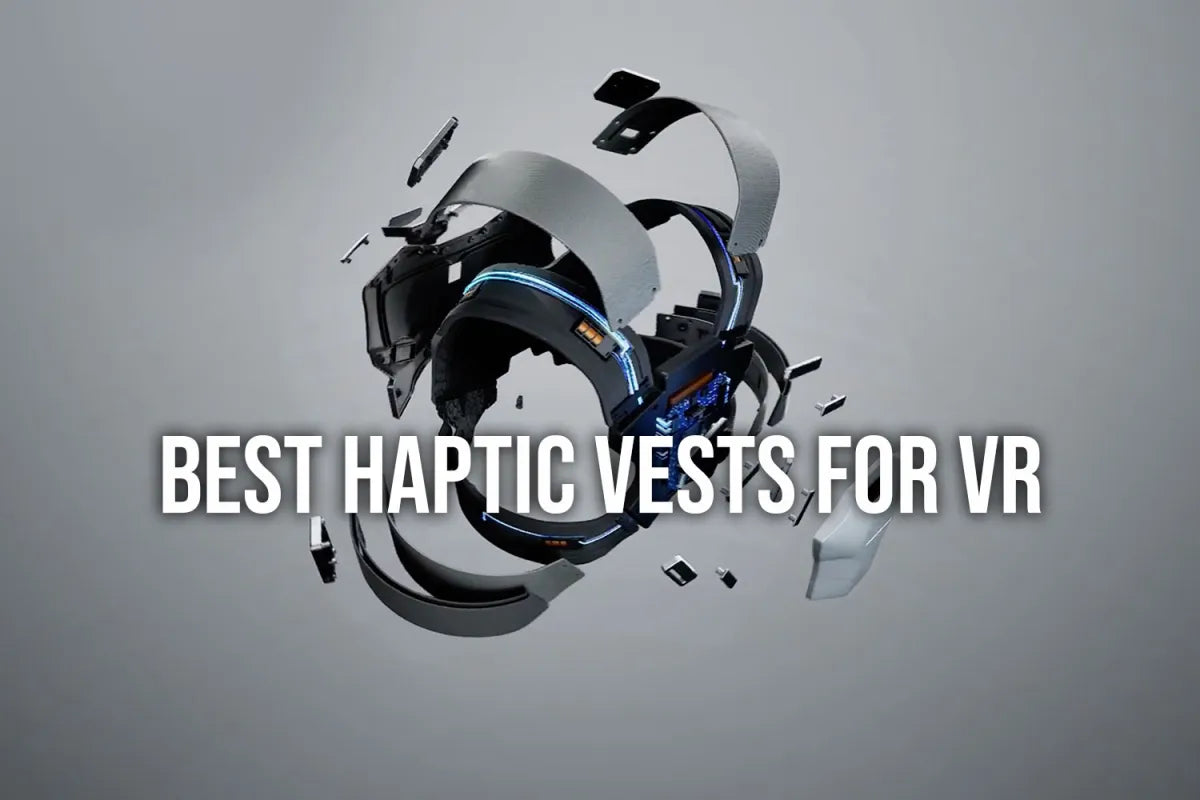Virtual Reality (VR) gamers are always looking for ways to get more immersion, be it with bigger FOV, higher pixel amounts, increased comfort, audio, a yoke or steering wheel, or even a treadmill. There are also popular peripherals that are haptic vests. These look straight out of ReadyPlayerOne, but they're not science-fiction. While visual and auditory aspects have long dominated VR, the introduction of haptic vests has elevated this technology to new heights, enhancing immersion and engagement in unprecedented ways.
Some of the best haptic vests for VR:
bHaptics Tactsuit X40

This vest is a great option for gamers who want a high-quality haptic experience. It has 40 haptic feedback points, which allows for a wide range of sensations, from gentle vibrations to powerful jolts. The Tactsuit X40 is also comfortable and lightweight, making it easy to wear for extended periods of time.
Woojer Vest Edge

This vest is known for its powerful haptic feedback, which can provide a truly immersive VR experience. The Woojer Vest Edge has 26 haptic feedback points, which are evenly distributed throughout the vest. This means that you can feel sensations all over your torso, from your chest to your stomach.
Actronika Skinetic Edge

This vest is a more affordable option, but it still offers a great haptic experience. The Skinetic Edge has 16 haptic feedback points, which are concentrated around the chest and abdomen. This makes it a good choice for gamers who want to feel the impact of explosions and gunshots.
Ultimately, the best haptic vest for you will depend on your individual needs and preferences. Consider your budget, the type of VR experiences you enjoy, and the level of immersion you want.
Here is a table that summarizes the key features of each of the three haptic vests:
| Feature | bHaptics Tactsuit X40 | Woojer Vest Edge | Skinetic Edge |
| Haptic feedback points | 40 | 26 | 16 |
| Haptic feedback intensity | High | Very high | Medium |
| Comfort | Lightweight and breathable | Slightly bulky | Lightweight and breathable |
| Compatibility | Works with a wide range of VR headsets and games | Works with a wide range of VR headsets and games | Works with a wide range of VR headsets and games |
Other haptic vests for VR
- - The Owo haptic vest (which uses electric shocks)
- - The Korfx haptic vest (very affordable)
- - The Teslasuit (which is more a suit than a vest)
- - Haptx gloves (so not really a vest)
- - Also Moonseer is working on a haptic vest
Understanding Haptic Vests
Haptic vests are wearable devices designed to deliver tactile sensations through vibrations or movements across the user's body. These vests enable users to feel and experience the virtual environment physically, complementing the visual and auditory elements of VR. They usually come in different sizes (as they're pieces of clothing).
Heightened Sensory Experience
Imagine stepping into a virtual world and not just seeing and hearing but feeling the environment around you. Haptic vests replicate sensations like impacts, textures, vibrations, and even environmental factors like wind or temperature changes. This multisensory integration significantly amplifies the sense of presence and realism within the virtual space.
Enhanced Gaming Adventures
In gaming, haptic vests bring a whole new dimension by translating in-game actions into physical feedback. Whether it's the thump of a gunshot, the rumble of an explosion, or the sensation of a character's movement, haptic vests intensify these experiences, making gaming sessions more immersive and thrilling.
Realistic Training Simulations
Industries such as healthcare, aviation, and defense utilize VR for training simulations. Haptic vests simulate real-world scenarios, allowing trainees to experience physical feedback, enhancing the learning process. Surgeons can practice procedures, pilots can simulate flight conditions, and soldiers can undergo tactical training—all with heightened realism through haptic feedback.
Empowering Accessibility
Haptic vests contribute to making VR more inclusive. For individuals with visual impairments or hearing disabilities, the tactile sensations provided by these vests offer an additional layer of interaction, making VR experiences more accessible and engaging.
Choosing the Right Haptic Vest
When considering a haptic vest for your VR adventures, factors such as haptic feedback precision, compatibility with VR systems and games, comfort, and customization options play crucial roles. Understanding your intended use—be it gaming, professional applications, or therapeutic purposes—helps in selecting the most suitable vest for your needs. And there's, of course, price.
The Future of Immersion
As VR technology continues to advance, so will haptic vests. Innovations in materials, haptic feedback precision, and integration with VR systems promise an exciting future where the boundaries between virtual and physical reality blur even further.
Haptic vests are not just accessories; they are gateways to a more immersive, sensory-rich virtual world. They bridge the gap between the digital and physical realms, opening doors to experiences that feel increasingly real.
Embrace the evolution of VR with haptic vests—step into a world where sensations meet simulations, and immersion knows no bounds.
This blog post highlights the transformative impact of haptic vests on the VR experience. It emphasizes how these vests enhance immersion, engage multiple senses, and broaden the applications of VR across various industries.








